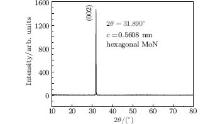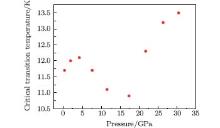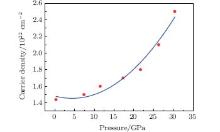Corresponding author. E-mail: yuxh@iphy.ac.cn
Corresponding author. E-mail: jin@iphy.ac.cn
Project supported by the Natural Science Foundation of Hebei Province, China (Grant No. A2014501010), the Youth Foundation of the Chinese Academy of Sciences (Grant No.Y4VX047X61), and the Chinese Academy of Sciences Project (Grant No.XDB07000000).
Effects of pressure and/or magnetism on the critical superconducting temperature ( Tc) of δ-MoN single crystal were investigated using a Maglab system. The δ-MoN single crystal was synthesized at extreme conditions of high pressure and high temperature. The carrier density of δ-MoN single crystal as a function of applied pressure was determined using Hall coefficient measurement.
δ -MoN is known to have interesting physical properties such as high Tc superconductivity, magnetism, low compressibility, and a high melting point. A number of experimental and theoretical works have been performed, which focus on the synthesis of δ -MoN single crystal and its fundamental physical properties, such as crystal structure, superconducting critical temperature, compressibility and phonon spectra.[1– 15]
It is well known that pressure is a very powerful tool for generating or tuning superconductivity by modifying the electronic structure without introducing defects or impurities.[16, 17] The behavior of a superconductor in a uniform static magnetic field has always been a subject of intensive experimental and theoretical investigations.[18– 20]
Bulk δ -MoN was first synthesized by Matthias and Hulm, [21] who reported that the superconducting critical temperature Tc is 12 K. Since then, several studies on the superconducting property of bulk δ -MoN have been reported. Bezinge et al.[4] performed high-pressure and high-temperature experiments on δ -MoN and reported that the superconducting critical temperature is 15.1 K. Soignard et al.[7] reported that the superconducting critical temperature of δ -MoN is below 12 K. Bull et al.[8] reported that the superconducting critical temperature of δ -MoN is 12.1 K.
Nanocrystalline δ -MoN was first synthesized by Gajbhiye and Ningthoujam, [22] who reported that the superconducting transition temperature of nanocrystalline δ -MoN is 7.5 K. Gomathi et al.[23] reported that nanoparticles of δ -MoN show a superconducting transition at a temperature of about 5 K.
More recently, Zhang et al.[24] reported the deposition of epitaxial δ -MoN thin films by a chemical solution approach under ambient pressure. Their δ -MoN thin film showed excellent superconducting properties with a critical temperature of 13.0 K.
To the best of our knowledge, there has been no report on the effects of pressure and/or magnetism on the superconductivity of δ -MoN single crystal to date. In this work, we focus attention on the effects of pressure and/or magnetism on the superconductivity of δ -MoN single crystal.
δ -MoN single crystal was grown under high pressure and temperature conditions. The synthesis method is described in published literature.[25, 26]
The resistance of δ -MoN single crystal at high pressure was measured using the standard four-probe method in a diamond anvil cell (DAC), as described in our previous work.[27– 30] The diamond culet faces was 500 μ m in diameter. A plate of T301 stainless was preindented from a thickness of 250 μ m to 60 μ m, and a center hole of 250 μ m in diameter was drilled. Cubic BN (cBN) fine powder was used to cover the gasket to keep the electrode leads insulated from the gasket. A center hole was also drilled into the cBN layer with a diameter of 100 μ m to serve as a sample chamber. The dimension of the δ -MoN single crystal was 80 μ m× 80 μ m× 5 μ m. The soft hexagonal boron nitride (hBN) fine powder was used as a pressure-transmitting medium that could provide a good quasi-hydrostatic pressure. The electrodes were slim Au wires with a diameter of 18 μ m. Pressure was scaled by ruby fluorescence methods.[31] The DAC was placed inside a Maglab system to perform the experiments. The Hall coefficient was measured using van der Pauw method.[32]
The x-ray pattern of the product is shown in Fig. 1. The result shows that the product is a pure phase, which is hexagonal MoN (δ -MoN) with c=0.5608 nm. The possible space groups of δ -MoN single crystal are P3m1 (164) or P63mmc (194).
Figure 2 shows the temperature dependence of the a– b plane resistance of δ -MoN single crystal at several pressures. It can be seen from Fig. 2 that the resistance of δ -MoN single crystal changes suddenly from a normal state of conductivity to superconductivity at low temperature. The superconducting transition is sharp with a transition width (from 90% to 10% resistance of the normal state) of 0.4 K.
Pressure has an unusual influence on the superconducting critical temperature Tc of δ -MoN single crystal, as shown in Fig. 3. From Fig. 3, it can be seen that the Tc of δ -MoN single crystal is 11.7 K at 0.3 GPa. Our result is in good agreement with previous reports.[8, 21] It was found that the Tc of δ -MoN single crystal increases with increasing pressure at pressures below 4.2 GPa. Between 4.2 GPa and 17.3 GPa, the Tc of δ -MoN single crystal decreases slowly with increasing pressure, which indicates that the superconductivity of δ -MoN single crystal is suppressed by reducing the volume. Above 17.3 GPa, Tc of δ -MoN single crystal begins to increase with increasing pressure up to 30.4 GPa, which is the highest pressure in our experiment. Since no structural transition was observed under pressures up to 37.7 GPa, [33] it is suspected that the unusual Tc(p) dependence might be due to a modification of the electronic configuration under applied pressure.[34] A similar anomalous change of Tc with pressure has been observed in rhenium, [35] MgB2, [36] and SrAlSi.[37]
When the temperature is above Tc, it can be observed that the resistance of δ -MoN single crystal increases monotonously with increasing temperature. This indicates that δ -MoN single crystal shows metallic conducting behavior.
To investigate the effect of magnetic field on the Tc of δ -MoN single crystal, we conducted measurements around the transition temperature at a varied level of external magnetic field. Our results are shown in Fig. 4. From Fig. 4, it can be seen that the Tc of δ -MoN single crystal drops with the strength of the applied magnetic field. The transition temperature Tc decreases with increasing magnetic field. This is strong evidence that this transition is superconductive in nature.[30]
Using the Werthamer– Helfand– Hobenberg formula[38]
 |
the upper critical field Hc2 was extrapolated to be 4.4 T at 20 K for H| | c when the δ -MoN single crystal was placed inside the DAC with magnetic field parallel to the c axis.
To study the effect of pressure on the carrier density n of the δ -MoN single crystal, we performed Hall coefficient measurement at 20 K. The applied magnetic field is perpendicular to the a– b plane of δ -MoN single crystal. We found that the carrier density monotonously increases with increasing pressure in a non-linear relationship, as shown in Fig. 5. The calculated result shows that the carrier density of δ -MoN single crystal is 1.48× 1022 cm− 3 at 0 GPa.
δ -MoN single crystal was synthesized at high temperature and high pressure, and its structure was determined using x-ray diffraction. Pressure was found to have an unusual influence on the superconducting transition temperature Tc of δ -MoN single crystal. Magnetism suppresses the transition temperature Tc of δ -MoN single crystal from a normal-state to superconducting state. Hall coefficient measurement shows that the carrier density monotonously increases with increasing pressure in a non-linear relationship. The carrier density of δ -MoN single crystal is about 1.48× 1022 cm− 3 at 0 GPa and 20 K.
| 1 |
|
| 2 |
|
| 3 |
|
| 4 |
|
| 5 |
|
| 6 |
|
| 7 |
|
| 8 |
|
| 9 |
|
| 10 |
|
| 11 |
|
| 12 |
|
| 13 |
|
| 14 |
|
| 15 |
|
| 16 |
|
| 17 |
|
| 18 |
|
| 19 |
|
| 20 |
|
| 21 |
|
| 22 |
|
| 23 |
|
| 24 |
|
| 25 |
|
| 26 |
|
| 27 |
|
| 28 |
|
| 29 |
|
| 30 |
|
| 31 |
|
| 32 |
|
| 33 |
|
| 34 |
|
| 35 |
|
| 36 |
|
| 37 |
|
| 38 |
|






